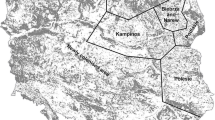Summary
In two forest areas of West Berlin the population-changes in three mouse species have been investigated over 28 years (1952–1979). Significant changes in absolute density have been established for the Short-Tailed Vole (Microtus agrestis) at 5-year intervals, for the Common Vole (Microtus arvalis) at 4-year intervals, and for the Yellow-Necked Field Mouse (Apodemus flavicollis) at 3-year intervals. The investigations were based on a total of 43,535 small vertebrates, 90% of which had been found in the pellets of breeding Tawny Owls. The remaining 10% belonged to pellets collected in the territories of breeding Long-Eared Owls. It is assumed that, for those prey animals whose percentage in the total prey of a predator is fairly high, the percentage proportionally approximates the real fluctuations in their (absolute) density.
Similar content being viewed by others
References
Chitty D (1960) Population Processes in the Vole and their relevance to general theory. Can J Zool 38:99–113
Frank F (1954) Die Kausalität der Nagetierzyklen im Licht neuer populationsdynamischer Untersuchungen an deutschen Microtinen. Z Morph Ökd Tiere 43:321–356
Frank F (1954) Beiträge zur Biologie der Feldmaus. Zool Jahrb (Syst) 84:32–44
Gaines MS see Krebs
Hamerstrom F (1979) Effect of Prey on Predator: Voles and Harriers. Auk 96:370–374
Hansson L (1979) Food as a limiting factor for small rodent numbers. Oecologia (Berl) 1979. 37:297–314
Keller BL see Krebs
Krebs CJ, Gaines MS, Keller BL, Myers JH, Tamarin RH (1973) Population cycles in small rodents. Science 17:35–41
Krebs CJ, Myers JH (1974) Population Cycles in small Mammals. Adv Ecol Res 8:267–399
Linkola P, Myllymäki A (1969) Der Einfluß der Kleinsäugerfluktuationen auf das Brüten einiger kleinsäugerfressender Vögel im südlichen Häme Mittelfinnland 1952–1966. Ornis Fennica 46
Myers JH, Krebs C (1974) Population Cycles in Rodents. Scient Amer 230(6):38–46
Myllymäki A (1969) see Linkola
Myllymäki A see Ryszkowski
Pelikan J (1966) Analyse von drei populationsdynamischen Faktoren bei Apodemus flavicollis (Melch). Z Säugetierk 31:31–37
Pitelka FA, Tomich PQ, Treichel GW (1955) Ecological relations of jaegers and owls as lemming predators near Barrow, Alaska. Ecol Monogr 25:85–117
Tamarin RH see Krebs
Ryszkowski L, Myllymäki A (1975) Outbreaks of Microtus arvalis and other Microtine Rodents in Central and Eastern Europe. Ecol Bulletin No 19 Swed Nat Sc Council Stockholm 57–64
Wendland V (1972) 14jährige Beobachtung zur Vermehrung des Waldkauzes (Strix aluco) J Orn 113:276–286
Wendland V (1975) Dreijähriger Rhythmus im Bestandswechsel der Gelbhalsmaus (Apodemus flavicollis) Oecologia 20:301–310
Wendland V (1977) Amphibien als Anzeiger von Änderungen des Grundwasserspiegels. Berl Naturschutzbl H 21
Author information
Authors and Affiliations
Rights and permissions
About this article
Cite this article
Wendland, V. Cyclic population changes in three mouse species in the same woodland. Oecologia 48, 7–12 (1981). https://doi.org/10.1007/BF00346981
Received:
Issue Date:
DOI: https://doi.org/10.1007/BF00346981




